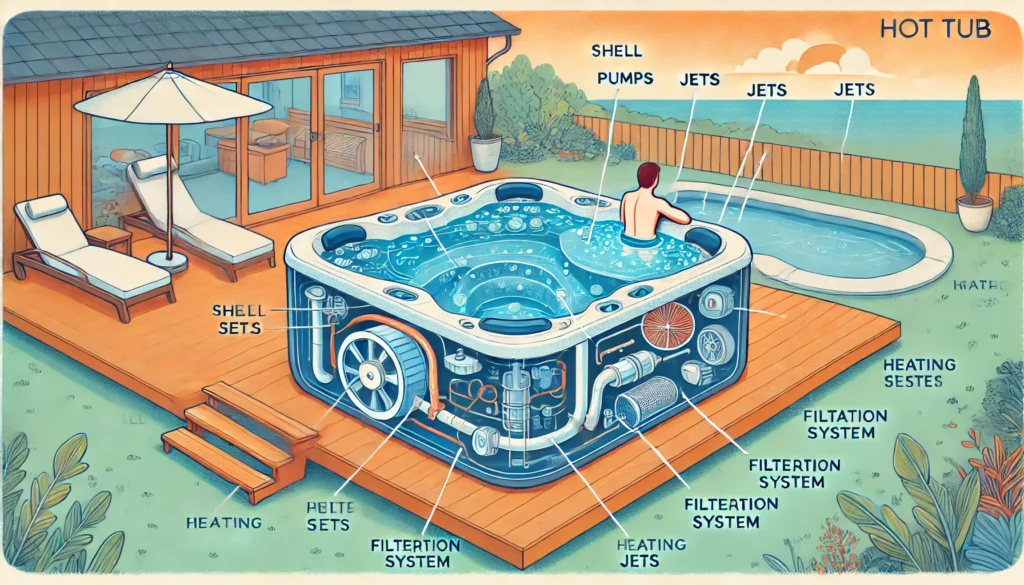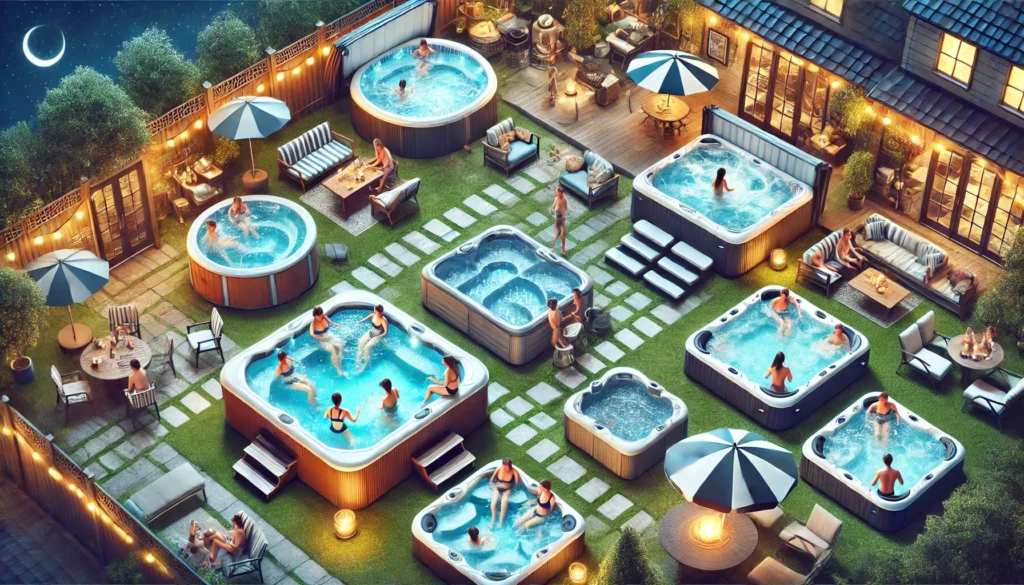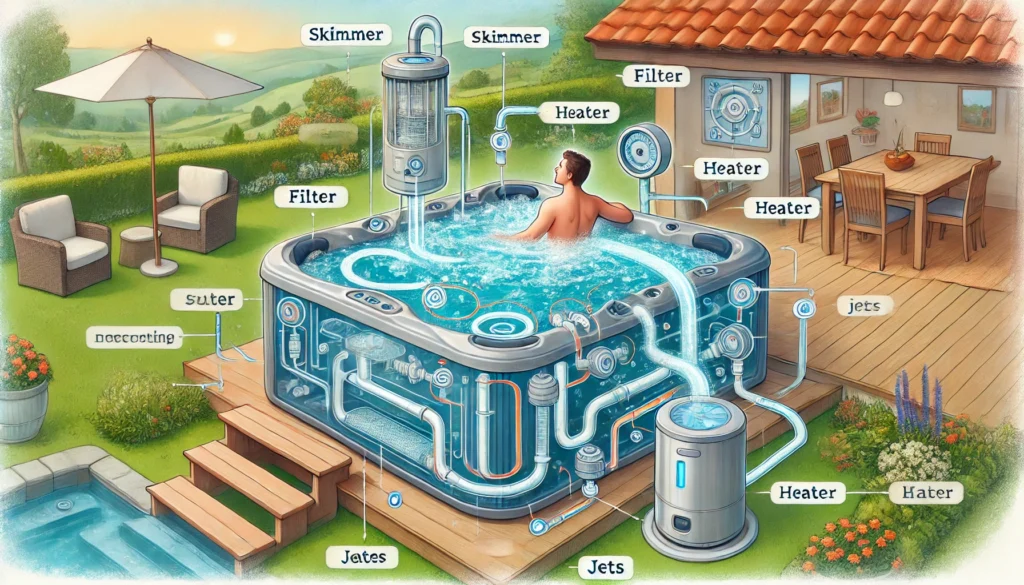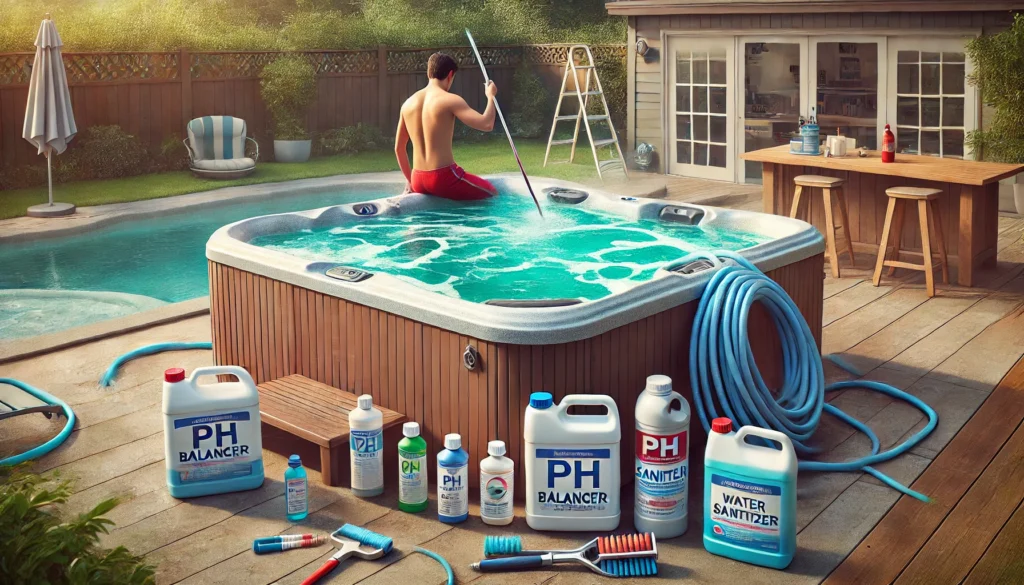Ah, hot tubs! Just the thought of sinking into those warm, bubbly waters makes me want to kick back and relax. I remember the first time I experienced a hot tub – it was at a friend’s backyard party, and I was instantly hooked.
But what exactly is a hot tub, and how does this magical contraption work its wonders? Well, buckle up, because we’re about to dive into the world of hot tubs, and trust me, it’s gonna be a splashing good time!
From the history of these watery wonders to the nitty-gritty of how they function, we’ll cover it all. So grab your favorite beverage, put on your comfiest robe, and let’s get ready to soak up some knowledge!
What Is A Hot Tub and How Does it Work?

A hot tub is a large tub or small pool filled with heated water and used for hydrotherapy, relaxation, or pleasure. It works by circulating water through a heating system and jets, creating a warm and bubbly environment.
The main components include a shell, pumps, jets, filtration system, and heating element. Water is heated, filtered, and pumped through jets to create a massaging effect.
We’ll dive deeper into the ins and outs of hot tubs below, but that’s the gist of what they are and how they function!
What is a Hot Tub?

Let’s start with the basics, shall we? A hot tub is basically a large tub or small pool filled with heated water that’s used for hydrotherapy, relaxation, or just plain ol’ fun. It’s like a personal oasis right in your backyard – or wherever you choose to put it.
Now, don’t get it twisted – hot tubs come in all shapes and sizes. You’ve got your portable ones, which are perfect for us renters or folks who like to move around a lot.
Then there’s the in-ground spas, which are like the fancy cousins of hot tubs, often built right into the ground alongside pools. And let’s not forget about those inflatable hot tubs – they’re like the scrappy underdogs of the hot tub world, but boy, do they get the job done!
I’ll never forget the time I tried to set up an inflatable hot tub in my tiny apartment. Let’s just say my neighbors weren’t too thrilled when they saw me struggling to get it through the door! But hey, where there’s a will, there’s a way, right?
People use hot tubs for all sorts of reasons. Some folks, like my buddy Mike, swear by them for soothing sore muscles after a workout.
Others use ’em for romantic evenings under the stars (wink wink). And then there’s people like me who just love to soak and chat with friends. It’s like a warm, bubbly social hub!
But here’s a fun fact for you: hot tubs aren’t just a modern invention. The concept of soaking in hot water for relaxation and health benefits dates back thousands of years!
Ancient Egyptians, Greeks, and Romans all had their versions of public bathhouses. And in Japan, they’ve been enjoying natural hot springs, called onsen, for centuries. So when you’re lounging in your hot tub, you’re actually partaking in a time-honored tradition. How’s that for feeling fancy?
Components of a Hot Tub

Alright, let’s get down to the nitty-gritty of what makes a hot tub tick. First up, we’ve got the shell and cabinet.
The shell is like the bathtub part – it’s what holds all that glorious water. Usually made of acrylic or some other durable material, it’s gotta be tough to withstand all that water and the weight of us hot tub enthusiasts!
The cabinet, on the other hand, is like the hot tub’s outfit. It’s the outer structure that houses all the internal components and gives the hot tub its finished look. Some are made of wood for that natural vibe, while others use synthetic materials for easy maintenance.
Next, we’ve got the pumps and jets. Oh boy, those jets! They’re the real MVPs of the hot tub world.
I remember the first time I sat in front of a jet – it was like getting a massage from a very enthusiastic octopus! The pumps are what give those jets their oomph, circulating the water and creating that heavenly bubble action.
But not all jets are created equal, my friends. Some are designed for broad, gentle massage, while others are like tiny power washers targeting specific muscle groups. It’s like having a whole team of massage therapists at your beck and call!
Now, let’s talk about the filtration system. It’s not the sexiest part of a hot tub, but trust me, you don’t want to skip this.
It keeps the water clean and free of all the gunk that can accumulate. And let me tell you, there’s nothing worse than stepping into a hot tub and feeling something… unidentified… brush against your leg. Yeesh!
The filtration system typically includes one or more filters (usually cartridge or sand filters) that trap debris and impurities as water passes through them. It’s like a bouncer for your hot tub, keeping out all the unwanted riffraff.
The heating element is what turns your regular ol’ tub into a hot tub. It’s responsible for keeping the water at that perfect, steamy temperature.
And let me tell you, there’s a fine art to getting the temperature just right. Too cold, and you’re basically sitting in a puddle. Too hot, and you’ll feel like a human soup!
Most hot tubs can heat water up to about 104°F (40°C), but the sweet spot for most people is around 100-102°F (37-39°C). It’s like Goldilocks finding the perfect porridge – not too hot, not too cold, but juuuust right.
Last but not least, we’ve got the control panel. This is where you get to play mad scientist, adjusting jets, temperature, and maybe even some fancy lights if you’re feeling groovy.
Just don’t be like me and accidentally hit the ‘cool down’ button when you’re trying to turn up the heat. Talk about a rude awakening!
Modern hot tubs often come with digital control panels that let you program your preferred settings. Some even have smartphone apps, so you can start heating your tub on your way home from work. Now that’s living in the future, folks!
How Does a Hot Tub Work?

Alright, folks, put on your thinking caps ’cause we’re about to get a little technical – but don’t worry, I’ll keep it as simple as explaining it to my gran after her third glass of wine!
So, the whole shebang starts with water circulation. The pump sucks water from the tub through something called a skimmer (which is like a little mouth that eats up leaves and bugs).
Then it pushes the water through the filter to clean it up. It’s kinda like how I run my dirty socks through the wash, except way more efficient and less smelly.
This circulation is constant when the hot tub is running, ensuring that the water stays clean and evenly heated. It’s like a never-ending game of tag, where the water is always ‘it’.
Next up is the heating process. The cleaned water passes through a heater, which is basically like a giant kettle.
It heats the water to whatever temperature you’ve set on the control panel. Pro tip: don’t set it too high unless you want to re-enact that scene from “The Lobster”!
The heater usually uses electricity, but some models use gas or even solar power. It’s like choosing between a microwave, an oven, or cooking your food with a magnifying glass on a sunny day – they all get the job done, just in different ways.
Now, here’s where the magic happens – the jet system. The heated water gets pushed back into the tub through those amazing jets.
They mix the water with air to create that bubbly, massaging effect that makes you go “Ahhh!” It’s like having a thousand tiny masseuses working on you at once. Trust me, after a long day of pretending to adult, there’s nothing better!
The number and placement of jets can vary widely between hot tub models. Some have just a handful, while others have enough jets to rival a rocket ship. It’s all about finding the right balance for your personal preference.
The filtration and sanitation part is ongoing. The water keeps circulating through the filter to catch any yucky stuff.
Most hot tubs also have a sanitizer system – usually chlorine or bromine – to kill bacteria. It’s like having a microscopic bouncer keeping all the bad guys out of your watery nightclub.
Some fancy hot tubs even use ozone or UV systems for additional purification. It’s like giving your water a spa day while you’re having a spa day. Talk about meta!
All these components work together in harmony to create that perfect hot tub experience. It’s like a well-orchestrated symphony, but instead of music, you get warm, bubbly relaxation. Now that’s what I call a masterpiece!
Maintenance and Care

Now, I know what you’re thinking – “This sounds great, but isn’t it a pain to maintain?” Well, I won’t lie to you – it does take some work. But hey, nothing worth having comes easy, right?
First up, we’ve got water chemistry. It’s like being back in high school science class, but way more fun! You’ve gotta keep the pH balanced, make sure there’s enough sanitizer, and check the alkalinity.
It sounds complicated, but trust me, once you get the hang of it, it’s a breeze. And hey, it’s a great excuse to pretend you’re a mad scientist!
You’ll need to test the water regularly – about once a week for most hot tubs. There are easy-to-use test strips that change color to indicate different chemical levels. It’s like a mood ring for your hot tub!
Cleaning is another biggie. You gotta scrub the shell regularly to keep it sparkling.
And don’t forget to clean the filter! I learned that the hard way when my hot tub started making some very un-relaxing noises. Turns out, filters don’t like being clogged with months of gunk. Who knew?
Most hot tub filters can be cleaned with a garden hose and some filter cleaner solution. It’s like giving your filter a spa day of its own. And trust me, a happy filter means a happy hot tub!
If you live somewhere that gets cold (and I mean really cold, not just “Oh no, I need a light jacket” cold), you might need to winterize your hot tub. This involves draining it and making sure no water is left in the pipes to freeze.
The first time I tried this, I ended up with a yard full of bubbles. Let’s just say, my neighbors got a free foam party!
But don’t let all this maintenance talk scare you off. Most of it becomes second nature after a while. And the payoff – having your own personal relaxation station – is totally worth it.
Plus, there are plenty of hot tub service companies out there if you’d rather leave it to the pros. It’s like having a hot tub butler. Now that’s living the dream!
Health Benefits and Considerations

Now, let’s talk about why hot tubs are more than just fun – they’re good for you too! First off, stress relief.
I swear, 15 minutes in my hot tub melts away stress faster than my ice cream melts in the sun. And trust me, that’s fast!
The warm water and massage from the jets can help relax tense muscles and calm your mind. It’s like a meditation session, but with bubbles. Om… bubble… om… bubble…
Hot tubs are also great for muscle recovery and pain relief. After I decided to try CrossFit (big mistake, by the way), my hot tub was my best friend.
Those jets work wonders on sore muscles. It’s like getting a deep tissue massage, but without the awkwardness of a stranger touching you.
The heat and buoyancy of the water can help improve circulation and reduce inflammation. It’s like a gentle, warm hug for your entire cardiovascular system.
Some folks even find that regular hot tub use helps with conditions like arthritis or fibromyalgia. Always check with your doctor first, but for many people, it’s a soothing addition to their treatment plan.
And let’s not forget about sleep! A soak in the hot tub before bed can help you drift off to dreamland more easily. The drop in body temperature when you get out of the tub can signal to your body that it’s time to sleep.
But hold your horses – before you go diving in, there are some things to consider. If you have certain health conditions, it’s best to chat with your doctor first.
And always, always follow the safety guidelines. Trust me, you do not want to learn the hard way why drinking and hot tubbing don’t mix. Let’s just say, floating face down is not a good look.
Pregnant women, people with heart conditions, and those with open wounds should be extra cautious. It’s always better to err on the side of caution when it comes to your health.
Also, remember to stay hydrated! All that heat can make you sweat, even if you don’t notice it. So keep a cool drink nearby (water, not margaritas!) to sip while you soak.
Conclusion
Well, folks, we’ve come to the end of our bubbly journey through the world of hot tubs. We’ve learned what they are, how they work, and why they’re basically the best invention since sliced bread (or maybe even better – can sliced bread massage your back? I think not!).
From the ancient Roman baths to the modern marvels in our backyards, hot tubs have come a long way. We’ve explored their inner workings, from the powerful pumps to the soothing jets, and even dipped our toes into the world of water chemistry.
Remember, a hot tub can be more than just a luxury – it can be a tool for relaxation, health, and creating memories. Whether you’re soaking away the stress of the day, easing those aching muscles, or just having a good time with friends, a hot tub can be a fantastic addition to your life.
But hey, don’t just take my word for it! Why not try it out for yourself? Rent one for a weekend, visit a spa, or take the plunge and get your own.
Just be warned – once you start, it’s hard to stop. You might find yourself becoming a hot tub evangelist like yours truly!
So, what are you waiting for? Dive in, the water’s fine! And who knows? Maybe you’ll discover your own hot tub tales to tell.
Just remember to keep the bubbles in the tub and the laughter loud. Happy soaking, everyone!
And remember, in the immortal words of… well, probably someone who owned a hot tub: “Life is better when you’re bubbly!” So go on, make a splash, and enjoy the warm embrace of your very own aquatic paradise. Your stressed-out muscles (and your fun-loving soul) will thank you!



